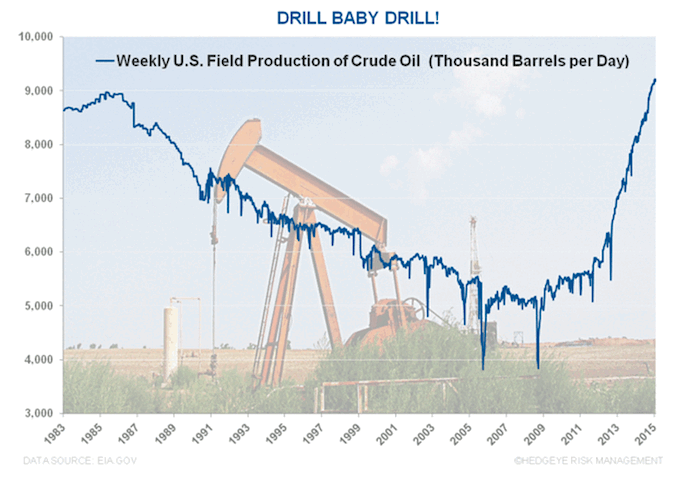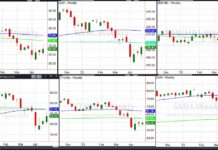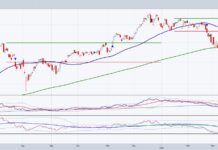As I mentioned in my weekly market commentary, the stock market’s bull case is that oil has bottomed. Never mind that the Bull’s case was that Crude Oil at $125 a barrel was also a bull catalyst.
The bottom line to me, though, is that I don’t believe that Crude Oil prices have bottomed yet… and I think they will most likely drop another 25% or more from current levels. As the chart below illustrates, even with the recent reduction in rig count, the supply of oil continues to increase (US Crude Oil production still has a ways to fall from its recent peak)! Worldwide demand has been falling faster than supply. In fact, supply remains at multi-decade highs and, due to the nature of the industry, it is going to take months and months for that to change. The most efficient producers can have positive cash flow as long as oil prices remain above $15 a barrel. Since most producers are heavily in debt and have to keep making interest payments or risk default, they are going to continue to pump oil as long as the price results in a positive cash flow. Their hope is that all their competitors go bankrupt before they do so they can survive the glut. The problem is that no one throws oil away—so if demand is less than production, that oil has to be stored somewhere and available storage is being rapidly depleted. As long as supply is greater than demand there is going to be downward pressure on oil prices.
In this update, I am presenting just a small part of the research that I’ve read on oil because it has significant repercussions on the direction of the stock and bond markets:
US Crude Oil Production Chart

Chart From Hedgeye Data sourced from EIA Gov
Here are five things that I believe are happening or are going to happen:
First, there are going to be a lot of oil and oil service companies that aren’t going to be able to service their debt. I also think that there are going to be some massive defaults as a result and MLPs should be avoided.
Second, these companies are cutting back their earnings estimates and oil and energy-related stocks have risk to the downside. There will be consolidation in the industry over time, but there is a lot of pain between here and there.
Third, these companies are laying off workers. Employment I the oil patch is decreasing, unemployment is increasing. It hasn’t shown up much in the employment numbers but it will. Keep in mind that the majority of labor gains over the last several years came mainly from the oil patch. Now that trend is reversing.
Fourth, lower oil prices help the consumer but are deflationary to the economy. The price of oil impacts the transportation costs associated with almost everything we consume. On the other hand, it doesn’t impact the price of housing, insurance, medical costs, etc. The impact on consumer budgets (in my opinion) is not going to result in big purchases so will not be as stimulative to overall economy or the stock market as the Bull’s think it will be.
Lastly, with inflationary pressures receding (disinflation), there probability of the Federal Reserve raising interest rates in 2015 is very low. Raising interest rates in a slow economy will result in driving that economy into a recession. The Federal Reserve is aware of that and will error on the side of caution. There’s little risk to the economy if they do nothing and are wrong because it will only eventually result in inflation (which they want anyway). I think it may be the middle of 2016 or later before we see interest rates rise.
So where do we go from here?
I continue to be remain defensive on stocks. I have been adding stock positions but still remain more heavily weighted in US Treasury bonds. This positioning has caused some pain over the past few weeks, but as more economic reports continue to show disinflation worldwide, I expect yields on US Treasury bonds to decline back below 2%. This is not a short-term trend and I think it is likely that 10- year UST bond yields can drop below 1.5%. Crude Oil prices won’t drop overnight—it will take months for this trend to play out and it won’t be in a straight line. The result will be a continued increase in market volatility while the Bulls and Bears battle it out.
Follow Jeff on Twitter: @JeffVoudrie
Author has positions in mentioned securities at the time of publication. Any opinions expressed herein are solely those of the author, and do not in any way represent the views or opinions of any other person or entity.







